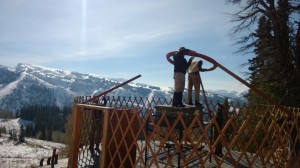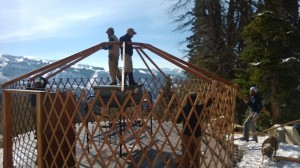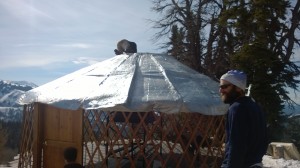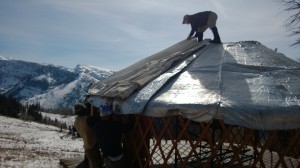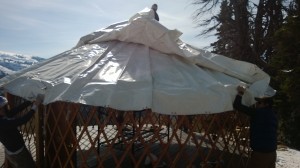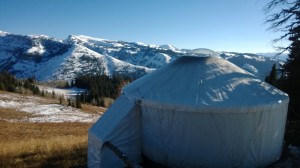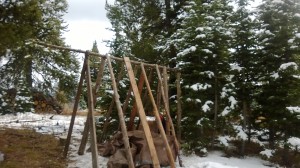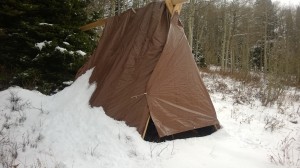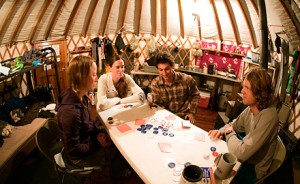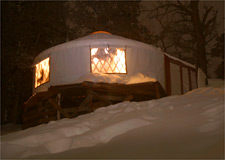For everything there is a season, and fall at Teton Backcountry Guides means re-constructing our yurts in the Teton mountains. Most folks who visit the yurts do not realize that every June at the end of the ski season, we completely dismantle every structure at the backcountry locations and pack things up and out. Then just about three months later, we unpack the whole thing and re-construct all the facilities again. Since we operate in the Greater Yellowstone Ecosystem, we have a special set of regulations that we have to work within, one of them being that we can not keep our yurts up year round.
It takes about 5-6 people to successfully set up the yurt. The first step after everything is unpacked is standing up and stretching out the latticework and measuring to make sure it is all the same height all the way around. The door is then placed in it’s position and the heavy duty cable is placed in the notches of the latticework. The cable is an integral piece to the yurt as all of the roof rafters rest on the cable.
There are two cruxes in the day, and by far, the most dangerous is placing the rafter’s pegs into the center ring. Two folks stand atop our “mountain scaffolding” which consists of a bunk bed with boxes on top to give us the necessary height. They will hold the ring while three to four other folks place the pin side of the rafter in the ring, and set the notch side of the rafter in the cable.
Once all the rafters are set, the next step is setting the insulation on the roof and then putting the topcover on. This can be tricky in that the topcover is heavy and does not move easily. There is also the art of lining up three pieces of fabric–the liner, the insulation and the cover–with the hole for the stovepipe. Careful folding of the cover when it is put away ensures that this process is easier in the fall.
After the cover is set, the side insulation is hung and the sidecover is secured to the topcover with a series of clips. Rafters are screwed to insure they can not release from the cable, brackets secure the lattice to the deck, and eyebolts and cord secure the topcover to the deck. Wind in the mountains can reach up to 80 mph and our yurts have to be able to withstand the rigors of the weather.
Once the yurt is built, the next phase includes building the vestibule over the door to keep the snow out and provide a place for wood storage.
Finally, the last structure to be built is the outhouse. Every year, a new location is selected, a 4 foot deep hole is hand dug, and using “pioneer construction”, we build a frame over the outhouse to provide cover in the stormy winter.
Once the yurt is up, the interior furniture is built. Everything is cleaned and painted and the woodstoves installed. Each yurt takes over one week to create the comfortable lodging that skiers arrive to each winter.
All of that hard work pays off when after a great day of skiing and riding untracked powder in the fabulous Teton backcountry, you shoosh to the yurt, your slopeside oasis in the Powder Zone. You stoke the woodstove, cook up a great meal for your friends, kick back and unwind and relish in your contentment. You can ski into the alpineglow, gaze at the stars, watch the moonrise over the mountains, and hear the howl of a coyote, all in the tranquility and peace the mountains provide, all just a few footsteps away from your bed inside the cozy yurt in the mountains.
